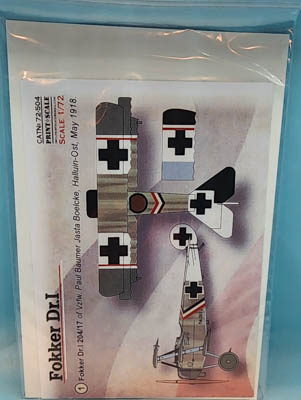
Print Scale 1/72 Fokker Dr.I
By Matt Bittner
To continue with aircraft of WWI, Print Scale has released this set of Fokker Dr.Is:
- Fokker Dr.l 204/17 of Vzfw. Paul Baumer Jasta Boelcke, Halluin-Ost, May 1918
- Fokker Dr.l 413/17 of Oblt. Karl Bolle Jasta Boelcke, Halluin-Ost, May 1918
- Fokker Dr.l 209/17 of Vzfw. Paul Baumer, Jasta Boelcke, Marcke, March 1918
- Fokker Dr.1 403/17 by Lt. John Janzen, Jasta 6, Lien St Amand, February 1918
- Fokker Dr.l 556/17 from Lt. Ludwig "Lutz" Beckmann, Jasta 6, Lechelle, March 1918
- Fokker Dr.l 195/17 from Lt. Hermann Vallendor, Jasta Boelcke, Halluin-Ost, May 1918

|
In general it appears the instructions are helpful. One thing to be aware of, though, is that the streaking was NOT applied in the direction of the line of flight, instead being applied diagonally on the upper surfaces. In addition, Print Scale shows the wheel covers in a solid color; this too should be "streaked", but not in the fashion one would think. The outer portion - nearest the tire - will be of a more solid color, which the inside of the wheel should be "lighter". For each scheme where there are known differences, I list those below.
For Baumer's 204/17, note that the tips of all three wings were painted black and not olive. Print Scale includes the red stripes that were also applied on the tops and bottoms of the middle and lower wing, next to a stripe of white, which was next to the black. On the upper wing, the red/white band next to the black only existed on the underside and not the top. Most Jasta Boelcke Triplanes had their cowls paint black with a white front plate, 204/17 included. There is some speculation that Baumer used a captured Le Rhone in 204/17, which could be evidenced by the use of a Nieuport prop early in its career. But when that was switched from the typical German engine is unknown, so finishing your model either way could be correct. One other addition is the center, cabane struts were mostly black, but white near where they attached to the upper wing. Also, the wheel covers could have been painted black.
For Bolle's 413/17, the only thing to keep in mind is since it too was a Jasta Boelcke machine, the cowl was black with a white front plate.
For Baumer's 209/17, in a series of photos it did NOT have the black/white cowl so follow Print Scale directions otherwise, minus the direction of the olve streaking.
The Print Scale directions for Janzen's Jasta 6 machine, 403/17, is mostly correct, the changes being a black cowl for Jasta 6 and the underside crosses background was left clear-doped linen and not white. Finally, Jasta 6 was known for creating a larger access panel on the port side of the nose, instead of the usual round access panel. To be true to the aircraft, a rectangular access panel would be more apt.
For 556/17, Beckmann's machine, the only comment to be made is the black cowl of Jasta 6 and the rectangular access panel.
The last machine in the decal line up is Vallendor's 195/17 also of Jasta Boelcke. As with the other Jasta Boelcke machines already noted, his also sported the black cowl with white front plate and possibly black-painted wheel covers. In addition, Vallendor flew with the Oberursel UR II (Rh) engine and had a tubular gun sight.
Regardless of all these additions, Print Scale does provide the correct markings for each plane. The only aspect - as I mentioned above - is the lack of proper paint and accessories application. My primary source of reference is the excellent book Fokker Dr.I Jagdstaffeln by Gregory VanWyngarden, published by Albatros Productions.
I definitely send my "thanks" to Print Scale for allowing me to review this set of decals.
